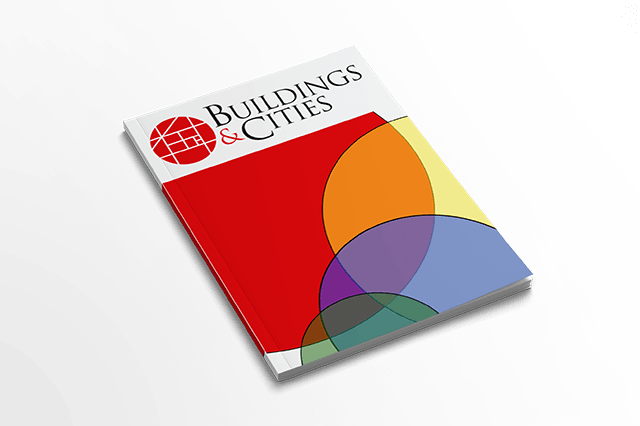
www.buildingsandcities.org/journal-content/briefing-notes.html
Briefing Notes

Introducing a new a new type of article aimed at practitioners
Welcome to Briefing Notes - a new type of article. Consistent with Buildings & Cities' objectives, Briefing Notes aim to make research topics more accessible and relevant to the end users of research: practitioners, clients, occupants and policymakers. Briefing Notes will provide readers with a concise summary, in plain English, of a what is known in a particular research field or topic and how to act on the results available.
Scope
Briefing notes will contain collated, research-based information about the built environment intended to support complex decisions made by the wide range of actors involved in its regulation, design, construction, operation, management, renewal and redevelopment. The scope of the notes will be multi-scale, multi-domain and life cycle oriented.
Practitioner Panel
An international Practitioner Panel will advise on strategic issues and the content of Briefing Notes:
- Identifying and prioritising topics for commissioning Briefing Notes
- Commenting on individual drafts and supporting the reviewing process, particularly on the relevance for practitioner implications and clarity of communication
- Connecting and promoting Briefing Notes to "communities of practice"
Reviewing
To ensure their robustness and value, Briefing Notes will be peer-reviewed just like other papers B&C publishes. However, due to their important role in knowledge transfer/exchange, Briefing Notes will have two broad types of reviewers:
- researchers (to ensure that the results cited are robust) and
- end-user practitioners (to ensure that the advice offered is sound and can be acted on).
List of Briefing Papers
Urban microclimate in temperate climates: a summary for practitioners
Rohinton Emmanuel
A summary is presented of current knowledge and key considerations in urban climate mitigation that have a bearing on planning practice in temperate climates. Urban climate is the intended or unintended local climate consequence of planning decisions at the street, neighbourhood and even city scales. Such local climate change adds to the changing global climate, where it both interacts with as well as exacerbates the human, energy, built environment and urban consequences of climate change. Although a relatively new field of study, knowledge about urban climate has sufficiently grown in recent decades to be of practical value to decision-making in the design and planning arenas. The climatic, wellbeing and carbon impacts of urban climate change are summarised along with best practices in mitigation and their relative merits. Key action points involve mapping heat vulnerability as well as enhancing heat resilience. It is hoped this briefing note will raise awareness of the wide range of issues involved in responding to the urban climate anomaly, whether in planning new districts or infilling existing ones.
KEYWORDS: cities, climate change, climate-sensitive design, heat stress, microclimate, thermal comfort, urban climate, urban form, urban heat island, urban planning
Summertime overheating in dwellings in temperate climates
Kevin J. Lomas
Summertime overheating in both new and existing dwellings is widespread and increasing, even in temperate climates. There is an urgent need to solve the problem. Flats (apartments) and small dwellings, especially those in cities, are particularly at risk. Elderly and vulnerable people are particularly affected. This briefing note presents current knowledge about this problem and what might be done about it. It is directed at planners, designers, policymakers as well as local authorities, housing associations and other organisations that manage stocks of dwellings.
- The research community and others have revealed the extent, severity and causes of summertime overheating in dwellings.
- Flats (apartments), even in temperate climates, are particularly at risk of overheating. But methods of construction and refurbishment and global warming are making the problem worse.
- Overheating affects mortality and morbidity, with the elderly and vulnerable particularly affected.
- Well-established passive heat-protection measures can, in most cases, prevent or remove the problem.
- Examples of good design practice are being verified through monitoring and occupant experience surveys.
- Professionals concerned with the design and refurbishment of dwellings must now focus on keeping them cool in summer as well as warm in winter.
KEYWORDS: apartments; design; dwellings; flats; housing; inhabitants; overheating; refurbishment; thermal comfort; vulnerability
Embodied carbon emissions in buildings: explanations, interpretations, recommendations
Thomas Lützkendorf & Maria Balouktsi
Embodied carbon is becoming an object of assessment not just in research but also in design and decision-making. It is becoming a key action to reduce GHG emissions. Embodied carbon assessment and reduction are being increasingly mandated in national regulations. Clients and designers (as key actors in the supply chain) can harness new knowledge and tools to reduce embodied carbon as part of a strategy to reduce overall GHG emissions. Appropriate methods, data, benchmarks and tools are being further developed and operationalised to support the processes for specifying and designing low carbon buildings. An overview is presented of the state of knowledge and current developments. Constructive recommendations are provided for actions that clients and designers can take.
- From the perspective of a single building's life cycle, the proportion of embodied carbon is around 50% on average for new energy-efficient buildings. From a macro-economic perspective, approximately 10% of global energy-related CO2 emissions are attributable to the embodied emissions of buildings.
- Designers can influence and assess embodied carbon according to related design targets in the client's brief and/or legal requirements.
- A trade-off between operational and embodied carbon is typical, but possibilities exist to optimise both sides.
- Embodied carbon can be reduced by selecting low carbon construction products and/or reused building components.
- Further possibilities are the revitalisation of existing buildings, the extension of their service life, the minimisation of useable areas (sufficiency), as well as the optimisation of buildings and their components.
- With good design, it is possible to construct low embodied carbon buildings with little or no additional costs, and even generate economic benefits.
KEYWORDS: building; building design; embodied carbon; environmental performance; greenhouse gas emissions; life cycle; net zero
Building within planetary boundaries: moving construction to stewardship
Matti Kuittinen
The consumption of materials and energy for construction is a serious challenge to contain global warming below 2°C. Rapid and drastic reductions in global carbon emissions and robust approaches to climate-related events are required urgently to remain within the planetary boundaries. A paradigm shift is needed: solving society's spatial needs without considering new buildings as the first solution. Instead, existing buildings should be used and renovated as far as possible. A new hierarchy for solving spatial needs is required: the Global North should avoid making new buildings, where and whenever possible. Instead, using existing spaces, renovating, adapting or extending the existing buildings would be much preferred. Such a hierarchy must be applied with context sensitivity. Especially the social needs of developing countries or communities recovering from humanitarian disasters should be adequately met, including the option of new construction. However, for most developed regions where populations are stable, new construction should require considerable justification. New design, business models and legislation are needed to successfully implement this approach.
KEYWORDS: built environment; climate change; construction; consumption; planetary boundaries; resources; sufficiency; trends
How urban green infrastructure contributes to carbon neutrality
R. Hautamäki, L. Kulmala, M. Ariluoma & L. Järvi
Reaching the carbon-neutrality targets of cities necessitates not only reducing emissions but also enhancing carbon sinks. This is enabled by urban green infrastructure (UGI), which is a cost-effective sink that provides numerous co-benefits beyond carbon sequestration. To fully harness this potential, it is essential to preserve existing carbon storage in urban planning, to create new multifunctional sinks, and to adopt low-emission practices in the construction and management of UGI.
- Urban vegetation and soils provide a cost-efficient method of carbon sequestration and storage (CSS) that can be used more efficiently.
- In addition to CSS, UGI provides other co-benefits: it helps to alleviate urban flooding and heatwaves and enhances biodiversity and wellbeing.
- There are three key elements to harnessing UGI for adapting and mitigating climate change: preserving existing carbon stocks in UGI; creating new multifunctional carbon sinks; and adopting low-carbon practices and design options.
KEYWORDS: urban green infrastructure; carbon storage and sequestration; carbon sink; climate change mitigation; urban planning; trees; vegetation; soil; built environment; planners
Latest Peer-Reviewed Journal Content
Youth engagement in urban living labs: tools, methods and pedagogies
N Charalambous, C Panayi, C Mady, T Augustinčić & D Berc
Co-creating urban transformation: a stakeholder analysis for Germany’s heat transition
P Heger, C Bieber, M Hendawy & A Shooshtari
Placemaking living lab: creating resilient social and spatial infrastructures
M Dodd, N Madabhushi & R Lees
Church pipe organs: historical tuning records as indoor environmental evidence
B Bingley, A Knight & Y Xing
A framework for 1.5°C-aligned GHG budgets in architecture
G Betti, I Spaar, D Bachmann, A Jerosch-Herold, E Kühner, R Yang, K Avhad & S Sinning
Net zero retrofit of the building stock [editorial]
D Godoy-Shimizu & P Steadman
Co-learning in living labs: nurturing civic agency and resilience
A Belfield
The importance of multi-roles and code-switching in living labs
H Noller & A Tarik
Researchers’ shifting roles in living labs for knowledge co-production
C-C Dobre & G Faldi
Increasing civic resilience in urban living labs: city authorities’ roles
E Alatalo, M Laine & M Kyrönviita
Co-curation as civic practice in community engagement
Z Li, M Sunikka-Blank, R Purohit & F Samuel
Preserving buildings: emission reductions from circular economy strategies in Austria
N Alaux, V Kulmer, J Vogel & A Passer
Urban living labs: relationality between institutions and local circularity
P Palo, M Adelfio, J Lundin & E Brandão
Living labs: epistemic modelling, temporariness and land value
J Clossick, T Khonsari & U Steven
Co-creating interventions to prevent mosquito-borne disease transmission in hospitals
O Sloan Wood, E Lupenza, D M Agnello, J B Knudsen, M Msellem, K L Schiøler & F Saleh
Circularity at the neighbourhood scale: co-creative living lab lessons
J Honsa, A Versele, T Van de Kerckhove & C Piccardo
Positive energy districts and energy communities: how living labs create value
E Malakhatka, O Shafqat, A Sandoff & L Thuvander
Built environment governance and professionalism: the end of laissez-faire (again)
S Foxell
Co-creating justice in housing energy transitions through energy living labs
D Ricci, C Leiwakabessy, S van Wieringen, P de Koning & T Konstantinou
HVAC characterisation of existing Canadian buildings for decarbonisation retrofit identification
J Adebisi & J J McArthur
Simulation and the building performance gap [editorial]
M Donn
Developing criteria for effective building-sector commitments in nationally determined contributions
P Graham, K McFarlane & M Taheri
Join Our Community

The most important part of any journal is our people – readers, authors, reviewers, editorial board members and editors. You are cordially invited to join our community by joining our mailing list. We send out occasional emails about the journal – calls for papers, special issues, events and more.
We will not share your email with third parties. Read more

Latest Commentaries
COP30 Report
Matti Kuittinen (Aalto University) reflects on his experience of attending the 2025 UN Conference of the Parties in Belém, Brazil. The roadmaps and commitments failed to deliver the objectives of the 2025 Paris Agreement. However, 2 countries - Japan and Senegal - announced they are creating roadmaps to decarbonise their buildings. An international group of government ministers put housing on the agenda - specifying the need for reduced carbon and energy use along with affordability, quality and climate resilience.
Building-Related Research: New Context, New Challenges
Raymond J. Cole (University of British Columbia) reflects on the key challenges raised in the 34 commissioned essays for Buildings & Cities 5th anniversary. Not only are key research issues identified, but the consequences of changing contexts for conducting research and tailoring its influence on society are highlighted as key areas of action.